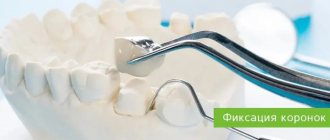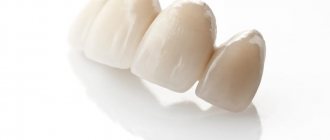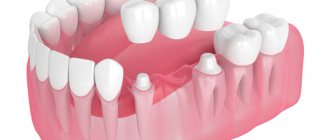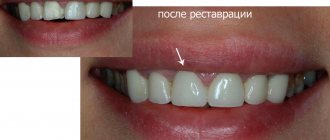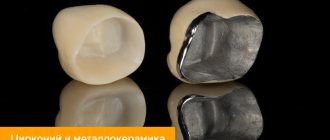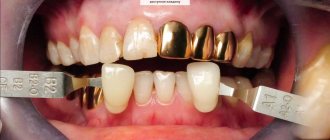Installing a crown on a tooth is one of the prosthetic options used when one or more dental units in a row are lost. Sometimes a dental crown is required even in the absence of a single edentia - for example, if it is necessary to restore the aesthetics of the dentition in the smile area. There are specific indications and contraindications for the procedure, and it is performed in several stages. We will discuss the specifics of the process of installing dental crowns in detail below.
After reading the material, you can find out how to install a crown on a tooth, what types of structures can be used in the procedure, and whether the process will be painful for the patient. We will also separately consider the specifics of removing a dental crown.
Calculate the cost of treatment by taking a short test in 20 seconds!
Do not delay your treatment, because in this matter time plays against us.
Prices at Doctor Zhuravlev Clinic
| Plastic crown (temporary) | PC. | 1000 rub. |
| Solid crown | PC. | 3600 rub. |
| Metal-ceramic crown | PC. | 6000 rub. |
| Metal-ceramic crown on an implant | PC. | 15,000 rub. |
| Zirconium oxide crown for implant | PC. | 16,000 rub. |
| Crown based on zirconium oxide | PC. | 13000 rub. |
| Endocrown | PC. | 12000 rub. |
| Pressed ceramic crown | PC. | 14,000 rub. |
| Stump tab | PC. | 3600 rub. |
Crown on a tooth
When the crown part of a tooth is severely damaged and its restoration may not be effective, even if a light-hardening gel filling is used, it makes sense to install a crown on the tooth. This will help keep it from being removed, which is especially important when good, undamaged roots remain. Modern dental treatment technologies make it possible to reach the canals of a pulpless tooth, completely disinfect them and seal them so that inflammatory processes in the gums cannot develop in the future. This guarantees a long service life of the dental crown.
Tooth restoration with filling
When the crown of a tooth has collapsed, what is more rational - modern prosthetics or restoration with durable filling materials?
If the molars are damaged, the doctor suggests restoring their functionality by installing a pin that strengthens the overall restoration. As a result, the desired effect will be achieved: you can chew again (but do not forget that overload is prohibited), the aesthetics of the molar will be quite acceptable. The tooth will look aesthetically pleasing - there are no external defects, the shape is even and anatomically justified.
Save a tooth with a pin or module
If a tooth breaks off and the natural crown is significantly damaged, a pin can again come to the rescue. With its help, you can strengthen the base and cover the tooth with an artificial crown or build it up with a polymer material.
The pins are made of both titanium and polymer; the alloy is biocompatible with body tissues and does not cause a negative reaction from tissues. The metal is durable - parts of the aircraft landing gear are made from it, so it can cope with chewing loads without problems. Installation of the structure is recommended when:
- Only parts of the real crown of the tooth remain (half or more is destroyed).
- The dentin is so damaged that the usual filling will not hold. Restoration with durable materials is required.
- It is necessary to restore the tooth under the covering of a prosthesis - permanent or removable.
The rod cannot be used if the root is destroyed (there is no support), if there is inflammatory gum disease, or if there is a cyst or granuloma under the problematic root.
Cerec modules
today it is much more effective than pins both in compatibility with the tooth and in strength.
And the main thing is the speed of restoration: any crown part of a tooth can be restored with the Cerec module in just 1-1.5 hours
.
The main condition for restoration is an intact tooth root. And, of course, the restrictions are the same as for pins: the presence of inflammation, cysts or granulomas under the problematic root is a direct contraindication. First, you need to eliminate these problems, and only then approach tooth restoration with the Cerec module.
Another interesting trend is the replacement of previously installed restoration pins with Cerec modules. This is due to the fact that pins still have their disadvantages, which can lead to tooth destruction, as shown in this video:
Tooth restoration with filling
Before starting the procedures, an examination is carried out - an x-ray or CT scan is performed. After making sure that there are no contraindications and the presence of a healthy root, the doctor decides to install a pin. When tooth damage is not critical - 30-40%, then restoration of the unit with filling compounds is completely justified:
- The pin is carefully mounted into the root canal, and cementation is performed.
- Next, the photopolymer composition is applied layer by layer. A filling is formed that replicates the physiologically justified tooth crown.
- The material is curing. The dentist polishes the surface, giving it a natural look.
In appearance, such a molar does not differ from neighboring teeth. But over time, the filling may change color.
If 2/3 of a tooth is damaged, installing a pin will help create a basis for strengthening the artificial crown. Filling is possible, but it is irrational - the tooth is fragile and will not withstand significant loads. Careless handling can provoke further breakdown of the unit, which can lead to complications. Therefore, in case of severe damage, placing a crown on a tooth is considered a reliable method of restoration.
What is a tooth crown: a little history
Strengthening teeth with crowns has been known for a long time, but previously they were made exclusively from metals, which often caused allergies and could lead to gum ulceration. The situation was aggravated by the fact that at that time there were no gel fillings, which in most cases could replace a crown. Therefore, it was necessary to resort to orthodontic care even with relatively small chips on the teeth. A modern dental crown looks just like a real tooth, and its color can be matched strictly to the shade of the patient’s tooth enamel. Indications for the installation of dental crowns have also been revised over time.
For example, previously crowns were used to mask chips. But if a metal crown is visible in the dentition, then the benefit of such “disguise” seems relative. Such a crown is more convenient to chew than a chipped tooth, the tooth underneath is protected from the formation of caries, but in terms of aesthetic parameters it does not stand up to criticism. Today, a small chip can be repaired with a filling, but a crown can now be installed on a pin or stump, even when the upper part of the tooth is completely destroyed.
What is a dental crown in prosthetics? This is the part of the bridge or clasp prosthesis that is put on the supporting teeth. Artificial teeth are attached to such crowns by one method or another, filling the row. Many people are afraid of bridge or clasp prosthetics because they do not know which teeth can be crowned and which cannot. At the same time, not everyone is a candidate for implantation, so we need to clarify the possibilities of modern dentistry.
How to properly brush teeth with dentures
The presence of crowns, inlays or dental bridges in your mouth should not embarrass you: you need to care for them and all other teeth in the same way as you did before:
- it is necessary to clean the oral cavity of plaque 2 times a day - morning and evening: using a toothbrush, make vertical movements from the gums to the cutting edge of the tooth, you can supplement such procedures with an irrigator,
- After each meal, you must use an irrigator, dental floss and interdental brushes (as indicated and with caution). Or at least rinse your mouth with a special product, or with regular warm water.
In addition to the restored teeth, living teeth and gums remained in the oral cavity. They need to be looked after, otherwise the risk of their premature loss increases. Remember that gum disease is five times more likely to lead to tooth loss than regular tooth decay and its consequences.
Which teeth are crowns placed on during prosthetics?
Today, the question “which teeth are crowned on” refers less to their location on the upper or lower jaw, but to the condition of the teeth themselves. If you need to remove the defect of only one tooth, on which a crown is installed for this purpose, then its condition can be initially any. But before it comes to making a crown, the tooth requires basic treatment. If a patient develops processes such as periodontitis, then first the doctor must go through all the canals and seal them using gutta-percha pins and filling material. The quality of root filling should be checked using an x-ray. If a cyst is found near the roots, then this is not always a reason to remove the tooth, but it requires longer treatment, the prescription of antibiotics and other drugs that help restore damaged soft tissue.
If the visible part of the tooth is completely destroyed, then the crown can be installed on the root using a dental inlay. If it comes down to tooth extraction, and the person agrees to implantation, then in this case, too, a crown is used, which “crowns” the implant, imitating the visible part of the tooth. But where to put the crowns, on the upper and lower teeth, it doesn’t matter. Even if it is necessary to properly heal wisdom teeth that a person chews normally, dental crowns can be installed.
Preparation for prosthetic crowns
Before any prosthetics, an examination of the oral cavity is required at the initial appointment. The condition of the teeth, roots, and periodontium is assessed. And before a crown is placed, the patient and the doctor go through several stages:
- Tooth preparation
. Cleansing the cavity from carious tissue. If necessary, depulpation and filling of canals. - Turning
(preparation) for the crown. This is necessary for a tight fit between the edges of the tooth and the prosthesis. The enamel is removed to the thickness of the crown. When choosing cast ones, less fabric is removed; metal-ceramic, ceramic - more. On average, about 2.5 mm. The result is a stump that looks like a stump, and a crown is attached to it. - Sometimes it is necessary to strengthen the root of a tooth
. In this case, a stump tab is first placed. Its pins are installed in the root canal, and the upper part of the stump is used to fix the crown. - When installing a crown on implants, the implant is implanted into the prepared hole, and a prosthetic crown is placed on the upper part.
- Taking an impression
, an impression using a plastic mass to model the dentition from plaster, which is necessary for the further work of the technician. - Making a crown
in a dental laboratory.
Important!
Treatment of the tooth on which the crown will be installed must be at a high level: all diseased tissues are removed, the nerve canals are completely cleaned and sealed correctly. It is important. Since if there is pain under the crown due to missed caries or others, it will be necessary to remove the entire structure and begin treatment and installation again.
What materials are used to make modern crowns?
Today, most materials for crowns are the color of natural tooth enamel, and metal crowns can still be installed only in the depths of the mouth, since they are not visible there, but this makes prosthetics generally cheaper. One more condition must be met: the patient is not allergic to metal. For allergy sufferers, crowns without metal impurities are recommended:
- plastic;
- ceramic.
A new material is also used - zirconium dioxide, which is not a metal in its pure form and takes root well in the oral cavity. If the patient is not short of money, he can order zirconium dioxide crowns, which are excellent in appearance and strength.
Metal dental crowns
- They are made either from gold or from a special medical alloy. In the latter case, it is a silver-colored metal. It is believed that gold is best suited to the human body; it does not oxidize and does not form dangerous compounds upon contact with saliva or food. However, gold looks beautiful as jewelry, and not when it is used to make a tooth, which by nature is destined to have a completely different color.
Metal ceramics
- In terms of strength, it is worth choosing metal-ceramic dental crowns, especially since they practically do not differ in color from natural tooth enamel. However, the presence of a metal-ceramic crown in the dentition can be revealed by its insufficient degree of transparency. The tooth turns out to be similar to a real one, but at the same time somehow “lifeless” in appearance. This is due to the fact that the inside of this crown is metal and the outside is ceramic. Opaque metal can be slightly visible through the ceramics, becoming an absolute barrier to light rays.
Solid ceramic
- These crowns are more fragile, but they look almost like natural tooth enamel. The biocompatibility of a crown made from solid ceramics is the highest. Doctors prefer to place such dental crowns on the front teeth, because the aesthetic factor plays a key role here. However, the patient is not recommended to bite off even an apple with a tooth with such a crown, not to mention nuts or other solid foods. Doctors advise keeping a knife with you that can be used to divide food into small pieces.
Zirconium dioxide
- A new and inexpensive material that has almost all the aesthetic properties of ceramics and the strength characteristics of metal ceramics is zirconium dioxide. This type of prosthesis is also called zirconium crowns. They are equally good to use both on chewing teeth and on the front teeth - incisors and canines. So far, only one drawback of zirconium dioxide crowns has been identified - high cost.
Plastic crowns
- Today it is possible to create plastic that would be similar to real tooth enamel and at the same time have good biological compatibility with the human body. Typically, a plastic dental crown is a temporary option. They do not last long, are stained by food and can crack. This type of crown is widely used during implantation - during the healing of the implant. Also, this “cap” can be used to cover a prepared tooth while a permanent crown is being made from a more expensive material.
Metal-plastic dental crowns
- The idea of a metal-plastic dental crown is the same as that of a metal-ceramic one. Only this type is cheaper. If the goal is to use such crowns on temporary structures or for a period of long-term treatment of a prepared tooth, then they are completely justified. But it would hardly be worth using such a product for more than three years. In addition to the disadvantages that metal-ceramic and plastic crowns have, metal-plastic structures have another flaw - the plastic lags behind the metal base. But as temporary dental crowns, they are a more durable option than just plastic.
Why did the crown fall out?
To begin with, about the reasons why the crown fell off (it is not so important whether the pin held it in place or not, whether there was an inlay, a tooth stump underneath it, or a dental implant abutment).
There are only 5 such reasons (the most common cases when a crown falls):
- The crown fell off because it had served its life - all dental prostheses have it (and the teeth themselves too). Your doctor will tell you what period the crown is designed for; as a rule, it is no more than 7–10 years;
- Dental hygiene was carried out irregularly and not of sufficient quality (the root may become inflamed or the crown may fall out due to inflammation of the gums - tissue displacement);
- The stump (or pin, thin wall of the tooth) has broken - the crown has fallen off because it has lost its support;
- In cases where a patient quickly discovers that their crown has fallen off, the orthopedic surgeon or technician who fabricated the prosthesis for the stump or implant sometimes becomes responsible for the incident;
- A crown that has fallen out due to increased stress (those same bad habits - from biting nuts to “eating” pen caps, not a single crown can survive them). By the way, not only the crown and the tooth underneath it can be damaged, but also the entire jaw (opening bottles with your teeth can dislocate it).
What to do if a dental crown falls off?
Modern dentistry can quickly and easily solve almost any dental problem, and cases where a crown has fallen out are no exception.
You just need to get an appointment with your dentist if your dental crown has fallen out as soon as possible.
The recovery process on the same day can take only a few minutes (if it is the installation of the same prosthesis).
But after a couple of days, under high loads on the tooth, it may break: then you will no longer need a new crown, but an implant or a pin, a ceramic inlay, or a bridge.
If the delayed treatment is forced (the person is on a business trip, out of town, or simply has a cold), if the crown has fallen off, you must do the following:
- brush the tooth (carefully so that the stump does not break);
- clean the denture (using toothpaste and a brush, then wipe it with sterile gauze and put it in a small box);
- reduce the load on the tooth (damage to it can complicate treatment).
Features of crowns on implants
During implantation, the entire tooth is made anew: both the part that replaces the root and the visible part. The types of crowns for implanted teeth are as follows:
- ceramic;
- zirconium.
The abutment for ceramic crowns is often made of zirconium dioxide so that dark metal does not show through the ceramic. If a chewing tooth is implanted, the crown can be made of zirconium dioxide, and the abutment can be made of metal. However, this design is also suitable for the smile area, if the patient is not very capricious or is somewhat strapped for finances. Dental crowns on implants can be chosen not only by aesthetics, but also by cost. And since the price of dental crowns varies greatly, you can choose the option that will be quite affordable for you. It is not necessary to install dental crowns made of metal-free ceramics! It will be easier to determine which dental crowns are best if you know what your budget will be. Therefore, you should try to make a preliminary calculation together with your doctor.
How to install a crown on a tooth
Installing a crown on a tooth requires several stages, and this task cannot always be solved in one day. Therefore, many people ask the question: where are dental crowns installed on teeth - in the orthopedic department or the therapeutic department. Usually, if it is a large clinic, then patients first have to communicate with a dentist-therapist, who carries out diagnostics and the necessary treatment of the tooth. But the preparation, impression making, fitting and installation itself take place in the orthopedic department.
When a small clinic deals with the installation of dental crowns, everything can be done by the same doctor. He tells the patient what types of dental crowns there are, how much they cost on their own, and how much the treatment will cost. Together with the patient, one or another option is accepted, after which a process begins, consisting of:
- diagnostics, at which a decision is made on the possibility of installing a crown of a certain type;
- preparation: most often the tooth has to be depulped and the canals filled; in rare cases, it is possible to place a crown on a living tooth - as a rule, if it is an integral part of a bridge prosthesis;
- grinding teeth for a crown, if necessary, installing a dental inlay;
- taking an impression of the jaw;
- manufacturing either a crown - if the tooth is repaired without an inlay, or an inlay - if there is a need for it.
Next, appropriate treatment is carried out. Either a dental inlay is placed under the crown, made from an impression, or a crown is placed. If we are talking about installing a tab, then it is secured with cement. The patient, as a rule, comes again to make an impression with an inlay and make a crown for it. At the next visit, the crown is adjusted, and then, if the fitting shows that the crown is suitable, then the treatment can be considered complete after the final installation. If the crown does not fit, then you have to first adjust it and then proceed with installation.
This is how a dental crown is installed on one tooth. If you need to restore several teeth at once, you can do them simultaneously. In this case, you can save on the stage of taking an impression.
Types of adhesive for dentures
As a rule, a person encounters this medical composition only in the dental office, when a specialist installs dentures or crowns for him. However, if necessary, you can glue the tooth yourself. If you have a financial problem and it is not yet possible to visit the dentist, you can temporarily use glue for dental crowns. Such medications have different compositions, depending on the technology of the manufacturing company.
Features of denture adhesives from several popular brands are shown in the following table:
There is a wide selection of such products on the shelves of pharmacies, and the best adviser on which adhesive to choose for dentures will be the dentist who installed the dental structures.
Is it possible to put a crown on a tooth with a living nerve?
It is possible to remove the nerve under the crown, but it will require considerable effort on the part of the dentist. It will be necessary to remove dental crowns in order to heal teeth that have begun to hurt, and this is associated with the risk of losing the orthopedic structure. A crown may not always need to be reinstalled after removal. That is why they try to remove the pulp with the nerve even from a healthy tooth, and only then install crowns or bridges. Cavities under the crown can also develop if the tooth is not treated properly. Based on this, dentists try to immediately place the prepared tooth under a crown or cover its surface with a temporary structure in order to limit the contact of the enamel-less surface with food.
When a dental crown is placed on a pin or on an inlay, they try to protect the surface of the tooth with a temporary filling while the main structure is being manufactured. Making dental crowns sometimes takes several weeks if the clinic is small and the dental technician is constantly busy with work.
What is the function of glue?
After examination and during the process of grinding the tooth, the orthopedist decides which crown is best to install: removable or permanent, restorative or supporting. The patient is also asked to choose a construction material; it can be metal, metal-ceramics, plastic, or a combined composition.
To fix a permanent structure, a long-term and durable cementing agent is required. It tightly, hermetically holds the prosthesis in place.
Removable crowns require more troublesome care and the patient requires temporary cement to hold them on the tooth surface. You can purchase a similar adhesive composition in the pharmacy department; the cost of the product varies from 140 to 400 rubles.
There are several types of glue that not only hold crowns and dentures in place, but also have additional effects:
- retain moisture without absorbing it (a similar product is recommended for patients with increased salivation);
- do not allow pathogenic bacteria to pass through;
- make your breath fresh - if the glue contains flavoring additives.
The fixed structure is fixed once, so composite cement is used, which provides a rigid connection for a long period. Regardless of the crown material, they are attached to the same fastening compound.
If you still have to remove the crown...
Sometimes you can hear very strange complaints from patients: “The dental crown hurts.” In fact, it is the tooth under the crown that hurts, because the crown itself is not living tissue. The question also arises: why should there be pain if the tooth is devoid of a nerve? Inflammation can also occur in the gum tissue, and it can already manifest itself as pain. Sometimes it happens that you just feel an unpleasant smell from under the crown, but there is no pain. But this is also a reason to remove dental crowns.
When dismantling such structures, it is important what dental crowns are glued to. Knowing this, you can try to dissolve the material with a substance that will not damage the tissue of the teeth and gums. After this, it will be much easier to remove the crown with forceps. It is often necessary to additionally break up the cement with a drill and a special bur so that the crown can be removed easily. The removal of the crown begins with a Kopp apparatus, a device that can make pushing movements, and ends with crown removal forceps.
There are also devices that work with compressed air. This is, for example, cronaflex. The procedure is more expensive due to the high cost of the device, but the crown is not damaged and can be reused.
If you use other methods, such as sawing, you will have to remove the dental crowns and install new ones after dental treatment. This will result in greater costs for the patient and will also take more time.
Once we know how dental crowns are removed, it remains to be seen whether the patient experiences pain during the process? If the reason for coming to the dentist is only the smell from under the dental crown, then when removing it there may not be any unpleasant sensations at all. After all, the smell may be a consequence of food and saliva getting under the crown, and not the development of caries under it. When a patient is brought to the clinic by a toothache, the dentist must first administer anesthesia, and only then get to work. Pain clearly indicates inflammation.
Whether a tooth hurts under a crown or not depends not only on its quality, and not always on how well the dentist installed it. Often, even the best dental crowns can fall off or the tooth underneath them begins to ache. This happens due to the poor condition of the gums and the sluggish inflammatory processes occurring in it. As soon as chronic inflammation worsens, pain symptoms may immediately appear.
This is why many doctors advocate long-term treatment before placing a crown on a tooth.
Stages of manufacturing and installation of a metal-ceramic crown and bridge.
So, what stages do you need to go through in order to have a crown or bridge made of metal ceramics in your mouth?
Preparing teeth for prosthetics
Before installing a crown, the tooth must be cleaned, treated, and old restorations removed.
Installation of the stump tab
If the tooth decay is very extensive and there is not enough tissue, then it may be necessary to install a stump inlay - a base for installing a crown.
Tooth turning
To obtain an ideal surface for the future crown to fit, the doctor gives the tooth a certain shape. To prevent food from getting in and causing caries to develop under the crown, in our Clinic we grind the tooth using the “ledge” method.
Taking impressions
To create the exact shape of the future crown, the doctor takes impressions of the teeth using a special impression mass, which subsequently hardens (model)
Making a crown
Using the resulting model of the equipment, a metal frame is cast in our laboratory, covered with ceramics and baked at high temperature. To give the crown strength and more reliable fixation, in our Clinic we use shoulder masses.
Fixation of the crown
The doctor fixes the resulting crown on a metal-ceramic frame using special cement.
If the crown comes off a tooth...
This also does not mean that the tooth will have to be removed. After all, even crowns with a zirconium frame, an expensive and high-quality material, can fall out. Parting with it is an unaffordable luxury if you have the opportunity to install it again. By the way, if the crown falls out on its own, this is a guarantee that it will not be sawed. Whatever materials are used to make crowns, it is almost always possible to re-attach them to the tooth, only with new cement. The main thing is not to lose the crown and bring it to the doctor.
Indications for crown installation
- A severely damaged tooth, more than 50%
, when a filling cannot restore it. The cause is most often advanced caries; - large chip due to injury. In this case, the root is intact. It is enough to put a crown on top to restore integrity;
- fluorosis A disease that manifests itself as stains on teeth that cannot be whitened. Appear from an excess of fluoride in the body;
- aesthetic restoration, in case of defects: curvatures, altered shape, dissatisfaction with the color of the enamel.
When a crown requires restoration
If you decide to install an inexpensive crown on a tooth, it may deteriorate over time. In addition to losing color, crowns may become cracked, or even parts may break off. Restoration of dental crowns is possible, but it must be done by a highly qualified specialist. You should not try to bleach the crown on your own if it has darkened, because you can completely ruin it. The cost of a dental crown per tooth will always be higher than going to the clinic for restoration.
If the crown of a tooth is broken, then it is preferable to go to the same clinic where you had it installed. It is better to do the same if the crown of a tooth falls out. Here it is best to come to the dentist who did the installation. He remembers or has notes in the medical record about how he placed it, what substances he used, so when your tooth crown falls off, he will know exactly what to do.
If you have neither pain nor suspicion that the structure may become loose or fall off, but simply feel discomfort after installing the crown, then this is also a reason to consult a doctor. Sometimes a defect may be revealed in the work of a dental technician. For example, the crown will be short or too protruding and interfere with the closure of the upper and lower teeth. All these shortcomings are eliminated at the expense of the clinic, not the patient.
Fixation of temporary crowns
If we consider the option of dental prosthetics as a bridge or temporary installation of a crown, then those structures that are installed in the oral cavity of our patients until permanent dentures or crowns are made. The main purposes of such structures in our dentistry include:
1. Prevention of infection of dental tissues by microorganisms; 2. Quick and convenient adaptation to crowns or dentures; 3. Protection of supporting teeth from chemical, temperature or other irritants; 4. Restoration of phonetic, chewing and aesthetic functions.
In order to fix a temporary crown, it is necessary to first treat the tooth or restore the cult inlay. Temporary crowns in our dentistry are done only in front of the patient, and this procedure lasts from 20 to 40 minutes. Temporary dentures and crowns are fixed with special temporary cements, which have healing properties and antimicrobial components.
In addition, the temporary crown can be removed without visiting the dentist, and fixed again after treatment. Here it should be taken into account that before installing a temporary or permanent crown, it is necessary to carefully prepare the base or teeth, since this is the most difficult and main stage in the implementation of prosthetics . This process includes drilling, filling, stone removal and other manipulations. This process does not cause an unpleasant feeling in the mouth of our patients, since our dentists install crowns on pulpless teeth from which the nerves have already been removed.
If you and your dentist decide to leave your teeth alive, then the preparation is carried out under local anesthesia. This procedure lasts from one to three hours. At this moment, you have the opportunity to forget about the discomfort. The only pain that can pierce the patient is the injection of the drug.
Let's look at the procedure for temporary fixation of crowns , so let's get started. Before starting the final fixation procedure, our specialists place it on temporary cement. Due to this, dentists are given the opportunity to observe how the tooth will react and whether the crown will close. With the help of temporary cement, they can remove crowns without damage or injury. If the crown is fixed with permanent cement, it can only be removed by sawing.
Let's consider the method of final fixation of crowns . If four weeks after wearing the crowns on temporary cement you are satisfied with everything, then our specialists will remove the crowns. After this, the temporary cement is cleaned and fixed with permanent cement. Before fixing crowns with permanent cement, you need to wait for a certain time and observe how the teeth behave, whether there are any irregularities or other defects. The difference between temporary and permanent cement is that temporary can be removed without damaging it and without damaging the teeth. If you have a crown installed with permanent cement, it will only be removed by sawing.
If after a month everything is fine and you have no complaints, then the crowns can be removed calmly, then the remaining cement will be cleaned off, and the crowns will be fixed with permanent cement. After all, if you even once put on a crown, even a temporary one, then you will no longer be able to do without them, and in order to save your time, they will install it on permanent cement.
The article was checked by: Aivazov Georgy Tigranovich
If you liked this post, share it with your friends and subscribers.
How much will a dental crown cost for one tooth?
Potential patients are wondering what the prices are for dental crowns. This information can be obtained from the website of a specific clinic. But you also need to take into account the cost of preparing the tooth. The doctor is also interested in the patient knowing which dental crowns are best and which one to choose, which is why he will be ready to calculate the cost of all stages of treatment.
If the patient is brought to the clinic for the restoration of dental crowns, then it is also advisable for him to consult with the doctor who will be involved in the treatment. It happens that a dental crown falls out after many years, and the clinic where it was placed no longer exists, and it is unknown where to look for a doctor. This does not mean that you will have to make the crown again. It is quite possible that the doctor will find a way to use the old crown if it has not yet served its useful life. Then there is an opportunity to save on the crown itself, but you need to know how much it will cost to restore or reinstall the crown.
Any dental work costs some money. If you independently calculate everything according to the price list, you may accidentally miss some mandatory operation and not include it in the total cost. Therefore, it is better to consult with a doctor, and if this is not possible, then try to make a preliminary calculation with the registrar.
